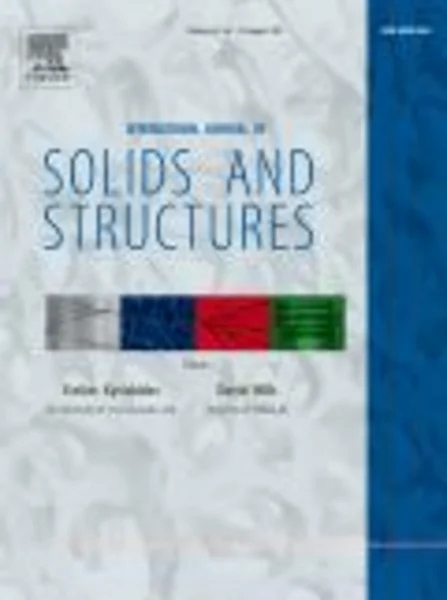-
on the effect of lüders bands on the bending of steel tubes. part ii: analysis
جزئیات بیشتر مقاله- تاریخ ارائه: 1392/01/01
- تاریخ انتشار در تی پی بین: 1392/01/01
- تعداد بازدید: 751
- تعداد پرسش و پاسخ ها: 0
- شماره تماس دبیرخانه رویداد: -
part ii of this study presents a modeling framework that is shown to successfully simulate all aspects of the inhomogeneous bending of tubes associated with lüders banding reported in part i. the structure is discretized with solid finite elements using a mesh that is fine enough for lüders bands to develop and evolve. the material is modeled as a finitely deforming, j2 type, elastic–plastic solid with an “up–down–up” response over the extent of the lüders strain, followed by hardening. regularization of the solution was accomplished by introducing a mild rate dependence of the material. simulation of the rotation controlled bending experiments confirmed most of the experimental observations and revealed additional details of the localization. thus, the initial uniform-curvature elastic regime terminates with the nucleation of localized banded deformation on the tensioned and compressed sides of the tube. the bands appear in pockets that propagate into the hitherto intact part of the structure while the moment remains essentially unchanged. the tube develops two curvature regimes; a relatively high curvature in the lüders deformed section and a low curvature in the unaffected one. simultaneously, the plasticized zone develops higher ovalization and wrinkles with a wavelength that corresponds to the periodicity of the banded pockets. for tubes with lower d/t and/or shorter lüders strain the higher curvature eventually spreads to the whole structure at which point homogenous bending resumes. for tubes with higher d/t and/or longer lüders strain the localized curvature, ovalization, and wrinkle amplitude are larger and cannot be sustained; the tube collapses prematurely leaving behind part of its length essentially undeformed. for every tube d/t there exists a threshold of lüders strain separating the two types of behavior. this bounding value of lüders strain was studied parametrically.
مقالات جدیدترین رویدادها
-
استفاده از تحلیل اهمیت-عملکرد در ارائه الگوی مدیریت خلاقیت سازمانی و ارائه راهکار جهت بهبود
-
بررسی تاثیر ارزش وجوه نقد مازاد بر ساختار سرمایه شرکت های پذیرفته شده در بورس اوراق بهادار تهران
-
بررسی تأثیر سطح افشای ریسک بر قرارداد بدهی شرکت های پذیرفته شده در بورس اوراق بهادار تهران
-
بررسی تأثیر رتبه بندی اعتباری مبتنی بر مدل امتیاز بازار نوظهور بر نقد شوندگی سهام با تأکید بر خصوصی سازی شرکت ها
-
تأثیر آمیخته بازاریابی پوشاک ایرانی بر تصویر ذهنی مشتری پوشاک ایرانی (هاکوپیان)
-
بررسی تاثیر مسئولیت اجتماعی شرکت بر عملکرد با تاکید بر نقش میانجی مدیریت منابع انسانی سبز در صنعت هتل داری
-
تراکم دینامیکی (بهسازی خاک )
-
معرفی و بررسی مقایسه ای روش های نوین صنعتی سازی ساختمان در سیستم های ساختمانی
-
افزایش جمعیت در جهان، گسترش فقر و تهدیدات آن بر امنیت بین الملل
-
learning behavioural context
مقالات جدیدترین ژورنال ها
-
مدیریت و بررسی افسردگی دانش آموزان دختر مقطع متوسطه دوم در دروان کرونا در شهرستان دزفول
-
مدیریت و بررسی خرد سیاسی در اندیشه ی فردوسی در ادب ایران
-
واکاوی و مدیریت توصیفی قلمدان(جاکلیدی)ضریح در موزه آستان قدس رضوی
-
بررسی تاثیر خلاقیت، دانش و انگیزه کارکنان بر پیشنهادات نوآورانه کارکنان ( مورد مطالعه: هتل های 3 و 4 ستاره استان کرمان)
-
بررسی تاثیر کیفیت سیستم های اطلاعاتی بر تصمیم گیری موفق در شرکتهای تولیدی استان اصفهان (مورد مطالعه: مدیران شرکتهای تولیدی استان اصفهان)
-
تاثیر بهبود فضای کسب و کار بر رشد اقتصادی در کشورهای منتخب اسلامی
-
تغییرات فعالیت آنزیم های آنتی اکسیدان و غلظت روی و آهن دانه در گیاه گندم triticum aestivum l تحت تاثیر برهمکنش منابع تامین نیتروژن و روی
-
بررسی توان ها و تنگناهای توسعه صنعت توریسم در شهر یاسوج با الگوی تحلیلی swot
-
solving elasto-static bounded problems with a novel arbitrary-shaped element
-
a survey study on the glass ceiling, challenges and solutions




سوال خود را در مورد این مقاله مطرح نمایید :